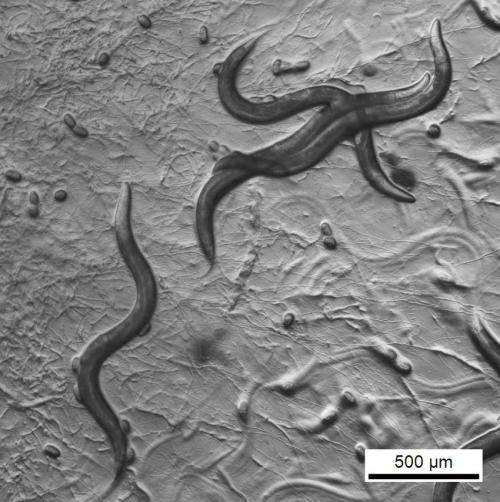The transparent nematode C. elegans, only 1 mm in length, has characteristics which include a short life cycle and a fixed number of cells. It serves as a model organism primarily for research in developmental biology, genetics, and neurobiology.
Neurodegenerative disorders such as Alzheimer's disease are typically characterized by protein deposits in the brain. These are comprised of defective, insoluble proteins which no longer fulfill their function and which cells are unable to break down. The work group headed by Professor Christian Behl of the Institute of Pathobiochemistry of the University Medical Center of Johannes Gutenberg University Mainz has determined the RAB3GAP complex as a novel factor that influences the efficient degradation of proteins. The researchers were able to show that the complex plays an important role in autophagy, a physiological process that breaks down cellular proteins and organelles. This insight opens up possible new options for the development of therapeutic and preventative approaches for neurodegenerative diseases. The work group has published the results of their research in the specialized journal Autophagy.
The team led by Professor Christian Behl and Dr. Andreas Kern showed that the RAB3GAP complex has a decisive influence on the process of protein degradation and represents an important element of the cellular autophagy network. Autophagy is a process in which cells digest their own components. These could be excessive or damaged organelles, such as mitochondria, invading pathogens, such as viruses or bacteria, or cytoplasmic macromolecules. Autophagy serves on the one hand for the recycling of the building blocks of cells and the provision of energy, but is also activated specifically in stress situations. "The controlled protein degradation by autophagy is a core aspect of protein homoeostasis, which means the complex interplay between the formation, folding, and decomposition of proteins. We have extended our understanding of age-related disorders by identifying new factors involved in this process," said Professor Christian Behl.
The research group discovered that the RAB3GAP complex promotes the formation of autophagic vesicles. These are bubble-like structures with a lipid shell that envelop the substrates to be degraded. The autophagic vesicles then fuse with lysosomes, simple cell organelles, which contain digestive enzymes that break down the substrates into their component parts. "The autophagic vesicles need lipid membranes to form, and the cell has to provide those.
Our discovery suggests that RAB3GAP recruits the lipids required for the autophagic degradation of proteins," explained Dr. Andreas Kern of the Institute of Pathobiochemistry, who was responsible for the experiments. It was previously known that the RAB3GAP complex is important for the regulation of the RAB GTPase RAB3, and that it influenced vesicle transport at the synapses, which are the contact points between nerve cells. The novel finding established that the complex indeed has a dual function, which is of particular relevance with regard to diseases of the nervous system.
The researchers made their discovery employing the nematode C. elegans, which serves as a simplified model, to study the human nervous system. In C. elegans, the biochemists were able to knock down approximately 2,500 individual genes using special molecular biological techniques and analyze the effects on protein aggregation. This allowed the identification of numerous genes that were associated with increased protein aggregation once they had been turned off. Subsequently, the precise functional characterization was completed using cultures of human cells.
The work group at the Institute of Pathobiochemistry was also able to demonstrate that the positive influence on autophagy by the RAB3GAP complex antagonizes that of a previously known negative autophagy regulator. "Our hypothesis is that it is the relative balance of the effects of these opposed molecules that determines the overall autophagic activity of cells. We believe that not only have we come closer to understand the autophagy process itself but also, and more importantly, that it may be possible to develop new approaches to the treatment and prevention of neurodegenerative diseases by means of targeted intervention in this process," stated Behl.
More information: N. Spang et al., RAB3GAP1 and RAB3GAP2 modulate basal and rapamycin-induced autophagy, Autophagy 10:2, 2297-2309, 28 January 2015, DOI: 10.4161/15548627.2014.994359
Provided by Universitaet Mainz





















